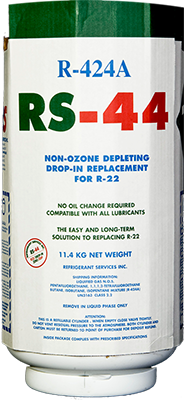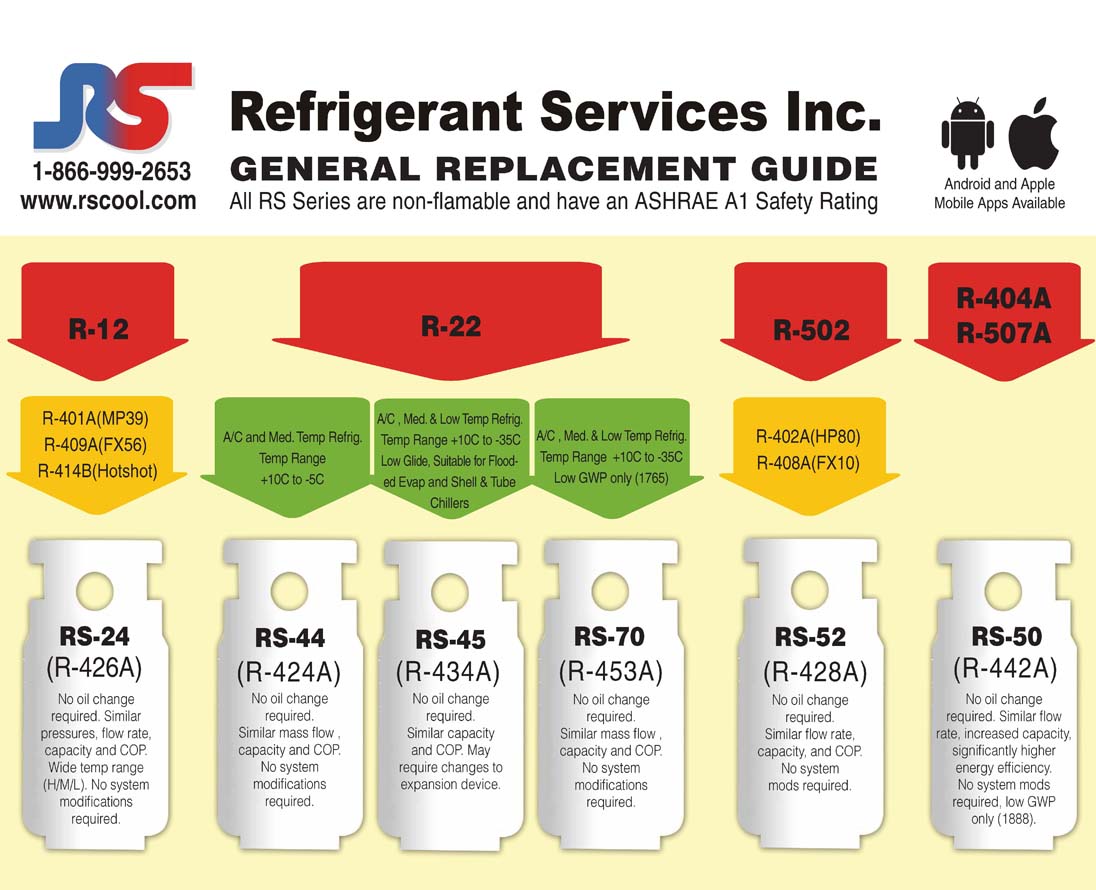RS-44 (R424A)
Type and Description
RS-44 is a non flammable blend of HFC 125, HFC 134a, n-butane, isobutane and isopentane which has a zero ODP and is also compatible with both traditional and synthetic lubricants so that a retrofit is not required.
RS-44 is a “Drop-in” replacement for R22 providing an easy and at the same time a long term solution. Because there is no need to use expensive and hygroscopic synthetic lubricants, the risk of moisture ingress into a refrigeration system is completely avoided. RS-44 has significantly lower discharge temperatures and pressures than R22 which removes the problem of oil decomposition and also widens the applications for RS-44.
Applications
RS-44 is suitable for use as a replacement for R-22 in new existing commercial and industrial air conditioning and refrigeration systems, and appliances.
Service Work
Because it is a blend, it is recommended that RS-44 be charged into systems as a liquid as opposed to the gaseous phase. Since there is no need to change the existing lubricant, RS-44 is straightforward to use, as the following procedure outlines.
Conversion Procedure for replacing R-22 with RS-44
Note : Thermostatic expansion valves will have to be adjusted to maintain the proper superheat after conversion. If the system is fitted with non-adjustable expansion valves they will have to be replaced with adjustable valves.(This could be done prior to conversion to reduce down time of the system during conversion.) For systems fitted with cap tubes or fixed orifices no modifications will be necessary.

- If possible collect baseline data before conversion. Suction and discharge pressures can be converted to temperature using an R-22 pressure temperature conversion chart. Once the average evaporating and condensing temperatures have been determined they can be compared to the same temperatures after conversion.
- Compressor oil levels and refrigerant charge should be recorded.
- Recover R-22 from the system.
- RS-44 (R-424A) is compatible with MO, AB and POE oils.
Note: if POE oil is used to replace MO or AB in the system, it is recommended that O-ring seals be replaced before charging the system. - Evacuate the system and charge with RS-44 (R-424A) to 90% of original R-22 charge.
Note: Remove refrigerant from the cylinders in LIQUID form to prevent fractionation. - It is recommended that the thermostatic expansion valves be closed 2-3 turns before starting the system. The valves can then be set to the proper superheat setting once the system has been started and conditions have stabilized.
- Start the system and check and compare baseline data, adjust thermostatic expansion valves as needed. Adjust all pressure controls to equivalent RS-44 (R-424A) values. If fitted adjust evaporator pressure regulators to maintain desired space temperatures.
- Check system charge and add refrigerant if needed to match original charge levels. If the system is fitted with a liquid line sight-glass and the sight-glass is not indicating a full charge additional RS-44 (R-424A) can be added. Avoid overcharging the system.
- Compare new data with baseline data and confirm that evaporating and condensing temperatures are similar to the original R-22 temperatures.
- Check system thoroughly for leaks.
- Clearly label the system as charged with RS-44 (R-424A) and type of oil used.
- Monitor oil levels for several hours of operation and add oil if necessary.
NOTE: Systems With Inherent Poor Oil Return, Such As Systems With Unusually Long Suction Lines May Have Improved Rs-44 Oil Return Capabilities With Alkylbenzene Or Polyolester Oils.
Lubricants
RS-44 is compatible with both mineral and alklybenzene oils found in R22 systems, and also with the polyolester lubricants. Therefore, there is no need to change the lubricant although compressor manufacturers’ recommendations regarding lubricity should be followed.
Materials Compatibility
RS-44 is compatible with all materials commonly used in refrigeration systems previously charged with R22.
In general, materials which are compatible with R22 can be used with RS-44. It is recommended to check equipment manufacturer’s retrofit literature and obtain recommendations from equipment manufacturers with regard to materials’ compatibility.
Environmental Data
None of the components of RS-44 contains chlorine so that it has no ability to deplete the ozone layer.
As with all hydrofluorocarbons (HFCs), RS-44 does have a direct global warming potential (GWP), but this is counterbalanced by its lower Total Equivalent Warming Impact (TEWI). Tests have shown that RS-44 has a higher Coefficient of Performance (COP) than R22 in a range of applications including commercial refrigeration systems, window air conditioners, and heat pumps both in the heating and cooling mode.
Composition
| HFC 125 HFC 134a n-butane isobutane isopentane |
|
| Chemical name | Pentafluoroethane/1,1,1,2-tetrafluorethane/n-butane/isobutane/isopentane |
| Type | HFC blend |
| HCFC replacement | R22 |
| Temperature glide | Approximately 4°C |
| Drop-in or long term | Both |
| Lubricant | MO/AB/POE |
| ODP | Zero |
| Atmospheric lifetime | 23 years |
| GWP 100 year ITH 500 year ITH |
2011 657 |
RS-44 Physical Properties
| RS-44 | R22 | ||
| Molecular weight | 108.1 | 86.5 | |
| Boiling point (1 atm) | °C | -38.7 | -40.8 |
| °F | -37.6 | -41.4 | |
| Temperature glide | °C | 4 | 0 |
| Critical temperature | °C | 88.8 | 96.1 |
| °F | 191.8 | 204.8 | |
| Critical pressure | bara | 40.4 | 49.9 |
| psia | 586 | 724 | |
| Liquid density at 25°C | Kd/m3 | 1169 | 1191 |
| Density of saturated vapour at 25°C | kg/m3 | 43.6 | 44.2 |
| Specific heat of liquid at 25°C | kj/kg°C | 1.43 | 1.26 |
| Vapour pressure at 25°C | bara | 9.67 | 10.4 |
| psia | 140.2 | 151 | |
| Latent heat of vaporisation at boiling point | kj/kg | 196 | 234 |
| Ozone Depletion Potential | ODP | 0 | 0.055 |
| Flammability limit in air (1 atm) | vol% | None | None |
| Inhalation exposure (8 hr day & 40 hr week) | ppm | 1000 | 1000 |

 A Cool New World.
A Cool New World. 